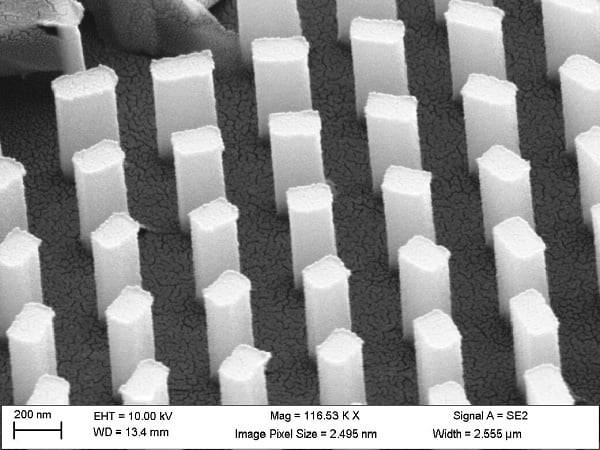CAMBRIDGE, Mass., June 11, 2021 — NASA earth scientist Kerry Meyer and researchers at Harvard University are developing metasurface technology capable of analyzing light along four polarization directions. With one flat optical component, intensity, linear polarization (horizontal and vertical), and circular polarization can be analyzed.
Light, such as sunlight traveling through the atmosphere, becomes polarized in different ways as it is scattered by water, vapor, ice, aerosols created by living organisms, dust, and other particulates. Polarization measurements enable the extrapolation of what is in the atmosphere.
“Up until recently, polarimeters have been pretty large instruments, and depending on the measurement strategy, could involve lots of moving parts and different optics,” Meyer said. “This metasurface technology splits the incoming signal into all four states.”

Electron microscope image of a metasurface, showing the raised nanopillar structures that direct light. Courtesy of Harvard/Noah Rubin.
With the moving parts removed, the technology could allow polarimetry to be adopted in small satellites such as SmallSats and Cubesats. The technology could also be scaled up for larger missions while significantly reducing cost, volume, weight, and power consumption.
While the technology is still in the early stages of its development, NASA scientist Dan Miller said a type of polarimeter is expected to be part of the planned Earth System Observatory on the Aerosol, Cloud, Convection and Precipitation (ACCP) mission recommended in the 2017 Earth Decadal Survey. The mission, which is expected to enter development this year, will combine polarimetry with lidar data to provide new insight into the clouds and particles of the atmosphere and their impact on life on Earth.
“The combination of a lidar and a polarimeter in orbit, observing the same target, tells you both what you’re looking at and the vertical distribution — where it is in the atmosphere,” Miller said. The data obtained from such missions could lead to better forecasting of weather, aerosol particles, and clouds, as well as a better understanding of how climate change could affect those processes in the future.
According to earth scientist Ed Nowottnick, the work additionally brings distributed observations of clouds and aerosolized particles closer to reality. “I could see flying this sensor in space as a constellation,” he said. “Then, you’re really going a long way toward understanding atmospheric processes.”
From information delivered from such a sensor, scientists would obtain better forecasts of weather, aerosol particles, and clouds, as well as a stronger understanding of how climate change could affect these processes in the future.